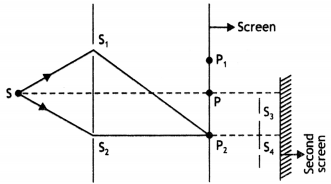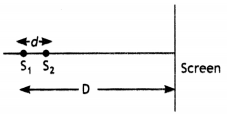Do you need help learning for your Class 12 Physics exam? Students may want to download NCERT MCQ Questions for Class 12 Physics Chapter 10 Wave Optics with Answers Pdf free download. This Wave Optics Class 12 MCQs Questions with Answers can help understand the concepts score better in your Class 12 Physics Exam, so make sure you practice these! Check out chapter-wise MCQ Questions for Class 12 Physics with Answers.
Wave Optics Class 12 MCQs Questions with Answers
Solve this Wave Optics Multiple Choice Questions of Class 12 Physics Chapter 10 MCQ, so as not to miss out on any concept from being clear about what they mean!
I. Choose the correct answer
Question 1.
In a Young’s doubles-slit experiment, the source is white light. One of the holes is covered by a red filter and another by a blue filter. In this case
(a) there shall be alternate interference patterns of red and blue.
(b) there shall be an interference pattern for red distinct from that for blue.
(c) there shall be no interference fringes.
(d) there shall be an interference pattern for red mixing with one for blue.
Answer
Answer: (c) there shall be no interference fringes.
Question 2.
Figure shows a standard two-slit arrangement with slits S1, S2. P1, P2 are the two minima points on either side of P (figure). At P2 on the screen, there is a hole and behind P2 is a second 2-slit arrangement with slits S3, S4 and a second screen behind them.

(a) There would be no interference pattern on the second screen but it would be lighted.
(b) The second screen would be totally dark.
(c) There would be a single bright point on the second screen.
(d) There would be a regular two-slit pattern on the second screen.
Answer
Answer: (d) There would be a regular two-slit pattern on the second screen.
Question 3.
In a Young’s double-slit experiment, the slits are separated by 0.28 mm and the screen is placed 1.4 m away. The distance between the central bright fringe and the fourth bright fringe is measured to be 1.2 cm. Determine the wavelength of light used in the experiment.
(a) 500 nm
(b) 600 nm
(c) 700 nm
(d) 600 Å
Answer
Answer: (b) 600 nm
Question 4.
In Young’s double-slit experiment the separation d between the slits is 2 mm, the wavelength X of the light used is 5896 A and distance D between the screen and slits is 100 cm. It is found that the angular width of the fringes is 0.20°. To increase the fringe angular width to 0.21° (with same λ and D) the separation between the slits needs to be changed to:
(a) 1.8 mm
(b) 1.9 mm
(c) 2.1 mm
(d) 1.7 mm
Answer
Answer: (b) 1.9 mm
Question 5.
The angular width of the central maximum in a single-slit diffraction pattern is 60°. The width of the slit is 1 mm. The slit is illuminated by monochromatic plane waves. If another slit of same width is made near it, Young’s fringes can be observed on a screen placed at a distance 50 cm from the slits. If the observed fringe width is 1 cm, what is slit separation distance? (i.e. distance between the centres of each slit)
(a) 50 mm
(b) 75 mm
(c) 100 mm
(d) 25 mm
Answer
Answer: (d) 25 mm
Question 6.
Two coherent point sources S1 and S2 are separated by a small distance ‘d’ as shown. The fringes obtained on the screen will be:

(a) points
(b) straight lines
(c) semi-circles
(d) concentric circles
Answer
Answer: (d) concentric circles
Question 7.
The Young’s double-slit experiment is performed with blue and green light of wavelengths 436 nm and 546 nm, respectively. If x is the distance of 4th maxima from the central one, then
(a) xblue = xgreen
(b) xblue > xgreen
(c) xblue < xgreen
(d) xblue / xgreen
Answer
Answer: (c) xblue < xgreen
Question 8.
In a Young’s double-slit experiment, slits are separated by 0.5 mm, and the screen is placed 150 cm away. A beam of light consisting of two wavelengths, 650 nm and 520 nm, is used to obtain interference fringes on the screen. The least distance from the common central maximum to the point where the bright fringes due to both the wavelengths coincide is:
(a) 9.75 mm
(b) 15.6 mm
(c) 1.56 mm
(d) 7.8 mm
Answer
Answer: (d) 7.8 mm
Question 9.
An interference pattern is observed by Young’s double-slit experiment. If now the separation between coherent sources is halved and the distance of screen from coherent sources is doubled, then fringe width
(a) becomes double
(b) becomes one-fourth
(c) remains same
(d) becomes four times
Answer
Answer: (d) becomes four times
Question 10.
A linear aperture whose width is 0.02 cm is placed immediately in front of a lens of focal length 60 cm. The aperture is illuminated normally by a parallel beam of wavelength 5 × 10-5cm. The distance of the first dark band of the diffraction pattern from the centre of the screen is:
(a) 0.20 cm
(b) 0.15 cm
(c) 0.10 cm
(d) 0.25 cm
Answer
Answer: (b) 0.15 cm
II. Fill in the blanks
Question 1.
Light has …………….. nature.
Answer
Answer: Dual
Question 2.
According to Huygen’s principle all points on a given wavefront are taken as ………………
Answer
Answer: point sources
Question 3.
A spherical wavefront Is due to a …………….. source of light.
Answer
Answer: Point
Question 4.
For sustained interference of light the waves emitted by the two sources must have a ………………… phase difference.
Answer
Answer: Constant
Question 5.
Two independent sources ……………….. produce sustained interference.
Answer
Answer: cannot
Question 6.
In Young’s double slit experiment, the fringe width is given by ………………..
Answer
Answer: ß = Dλ/d
Question 7.
Fringe width is different as the separation between two consecutive ………………… or ………………
Answer
Answer: Maxima, minima
Question 8.
Continuous locus of oscillation with constant phase is called ………………
Answer
Answer: Wavefront
Question 9.
……………… of light occurs when size of the obstacle of aperture is comparable of wavelength of light.
Answer
Answer: Diffraction
Question 10.
In interference and ……………….., the light energy is redistributed which increases in one region and decreases in other.
Answer
Answer: Diffraction
Question 11.
Poloroid is a device to produce and detect ……………….. polorised light.
Answer
Answer: Plane
Question 12.
A beam of light is incident normally upon a polariser and the intensity of emergent beam is l0. The intensity of the emergent beam is found to be unchanged when the polariser is rotated about an axis perpendicular to the pass axis. Incident beam is ……………….. in nature.
Answer
Answer: Unpolarised
Question 13.
Polarisation phenomenon are exhibited by the …………………. waves only.
Answer
Answer: Transverse
Question 14.
The value of Brewster Angle depends on the nature of the transparent refracting medium and the ………………….. of light used.
Answer
Answer: Wavelength
Question 15.
At polarising angle the refracted and reflected are ……………….. to each other.
Answer
Answer: Perpendicular
Question 16.
The intensity in sunglasses and window panes can be controlled by ……………….
Answer
Answer: Polaroid
Question 17.
Intensity of light is determined by ……………….. of the amplitude of oscillating electric field.
Answer
Answer: Square
This NCERT MCQ Questions for Class 12 Physics Chapter 10 Wave Optics with Answers Pdf free download has been put together to help students understand the CBSE Class 12 Physics Wave Optics MCQs Multiple Choice Questions with Answers. Hope you found this helpful!